VLA Data Combination-CASA4.6.0: Difference between revisions
No edit summary |
|||
| (50 intermediate revisions by the same user not shown) | |||
| Line 1: | Line 1: | ||
[https://casaguides.nrao.edu/index.php?title=VLA_Data_Combination-CASA5.0.0] | |||
'''This tutorial was created and tested using CASA 4.6.0''' | '''This tutorial was created and tested using CASA 4.6.0''' | ||
| Line 4: | Line 6: | ||
== Introduction == | == Introduction == | ||
The VLA can be configured into [https:// | A perfect image requires measurement of all spatial scales, which is equivalent to filling in the complete uv plane. Unfortunately, this can never be achieved with an aperture synthesis interferometer although a large number of baselines, long integration times, and multi-frequency-synthesis are all good approaches to increase the uv-coverage. One method to obtain more baselines is to observe in different array configurations and to combine the data afterwards. Deconvolution algorithms are then given good starting conditions to interpolate over the gaps in the uv-plane to achieve an improved image - an image that combines the surface brightness sensitivity of the compact baselines with the spatial resolution of the extended baselines. : | ||
The VLA can be configured into [https://go.nrao.edu/vla-res four principal array configurations, A, B, C, and D.] A is the most extended and D is the most compact configuration. Consequently, A configuration data exhibits the highest spatial resolution whereas D configuration delivers the best surface brightness sensitivity and also images the largest scales of the sky brightness distribution. | |||
In this tutorial, we will combine data from | In this tutorial, we will combine data from three VLA configurations (A & B & C) that were obtained in a monitoring campaign of Sgr A*, the central supermassive black hole of our Milky Way. | ||
== Typical | == Typical Observing Times == | ||
When an object is being observed by the VLA in different configurations, | When an object is being observed by the VLA in different array configurations, integration times are ideally matched to reach a common surface brightness sensitivity for all scales. Adjacent VLA configurations result in synthesized beams that differ in linear size by approximately a factor of 3. The beam areas therefore change by factors of ~10 and the more extended configuration would ideally need to have 10 times more integration time than the next compact one. This, however, is frequently not very practical and it turns out that integration times that differ by factors of ~3 are delivering data that can be combined satisfactorily as it matches the sensitivity of overlapping VLA visibilities when data are convolved to the same scales. | ||
This rule, however, is only a guidance and any data that | This rule, however, is only a guidance and any data that are being obtained from any configuration can be combined although overlapping uv-coverages are strongly recommended. Weighting will be primarily achieved during imaging by the [https://casa.nrao.edu/casadocs/stable/synthesis-imaging/data-weighting "Briggs"] scheme that allows one to adjust imaging weights between the "natural" and "uniform" extremes, i.e., between weighting by the number of visibilities that are gridded in each cell and weighting by the cells themselves. | ||
In addition, each visibility exhibits weights that should only depend on integration time, bandwidth, and system temperature. The VLA, however, currently does not measure Tsys | In addition, each visibility exhibits weights that should only depend on integration time, bandwidth, and system temperature. The VLA, however, currently does not measure Tsys. Visibility weights between different observations will therefore need to be adjusted as described below before they can be combined. | ||
== The | == The Data == | ||
In the following we will combine three different datasets from the | In the following we will combine three different datasets from the [https://science.nrao.edu/science/service-observing NRAO Monitoring of the Galactic Center/G2 Cloud Encounter]. We will combine S-band A, B, and C configuration data. The data were all calibrated and the science target split out. | ||
The measurement sets can be downloaded here: | The calibrated measurement sets can be downloaded here: | ||
[https://casa.nrao.edu/Data/EVLA/SgrA/VLA-combination-SgrA-files.tar.gz https://casa.nrao.edu/Data/EVLA/SgrA/VLA-combination-SgrA-files.tar.gz] (1.4GB) | |||
[https://casa.nrao.edu/Data/EVLA/SgrA/VLA-combination-SgrA-files.tar.gz https://casa.nrao.edu/Data/EVLA/SgrA/VLA-combination-SgrA-files.tar.gz] (1.4GB) | |||
| Line 32: | Line 34: | ||
</source> | </source> | ||
This will unpack three MeasurementSets, one for each array configuration: | |||
<pre> | <pre> | ||
| Line 44: | Line 46: | ||
== Initial Imaging == | == Initial Imaging == | ||
We will inspect the data and create separate images to better understand the image parameters such as integration time, resolution, and rms. | |||
Start CASA as usual via | Start CASA as usual via | ||
| Line 53: | Line 55: | ||
</source> | </source> | ||
As a first step, let's have a look at the {{listobs}} output for the different MeasurementSets. For example, the A-configuration MS has the following structure: | |||
<source lang="python"> | <source lang="python"> | ||
| Line 150: | Line 152: | ||
</pre> | </pre> | ||
We see that A-configuration contains only the central source, "J1745-2900" which is a different name for Sgr A*. The integration time | We see that A-configuration contains only the central source, "J1745-2900", which is just a different name for Sgr A*. The integration time amounts to only six minutes and the 16 spectral windows span a frequency range from 1.988 to 4.012GHz. Inspection of the other array configuration files show almost identical setups. Although the integration times between the different array configurations do not follow the 1:3:9 ratios that we discussed in the previous section, we can still combine the data without any problems. In the end, having better signal to noise on the shorter baselines can only improve the overall, combined image. | ||
To better understand the data, let's check the uv-coverage of each of the three datasets: | |||
<source lang="python"> | <source lang="python"> | ||
| Line 165: | Line 167: | ||
plotuv(vis='VLA-SgrA-Sband-Cconfig.ms') | plotuv(vis='VLA-SgrA-Sband-Cconfig.ms') | ||
</source> | </source> | ||
The uv-coverage plots are shown in Fig. 1. The u:v aspect ratio of each uv-coverage is high as Sgr A* is a very southern source. We also see that the longest baseline in each array differs by about a factor of 3 between the three configurations, as expected from the VLA A, B, and C configurations. | |||
{| | {| | ||
|[[Image:VLA-comb-A-uvcover_fld0.png|400px|thumb|left|'''Figure | |[[Image:VLA-comb-A-uvcover_fld0.png|400px|thumb|left|'''Figure 1a:''' <br />UV-coverage of A-configuration data.]] | ||
|[[Image:VLA-comb-B-uvcover_fld0.png|400px|thumb|left|'''Figure | |[[Image:VLA-comb-B-uvcover_fld0.png|400px|thumb|left|'''Figure 1b:''' <br />UV-coverage of B-configuration data.]] | ||
|[[Image:VLA-comb-C-uvcover_fld0.png|400px|thumb|left|'''Figure | |[[Image:VLA-comb-C-uvcover_fld0.png|400px|thumb|left|'''Figure 1c:''' <br />UV-coverage of C-configuration data.]] | ||
|} | |} | ||
To | |||
The next step is to determine the image quality, the synthesized beam, and the rms of each image. To do so, the images do not have to be perfectly deconvolved as we only would like to see how the combination will improve over the individual arrays. | |||
To keep things simple, we will use common cell sizes of 0.1 arcsec, images of 1280 pixels on each side, and we will {{clean}} 1000 iterations (see the [http://casaguides.nrao.edu/index.php/VLA_CASA_Imaging VLA CASA imaging guide for more sophisticated imaging parameter choices]): | |||
<source lang="python"> | <source lang="python"> | ||
# In CASA | # In CASA | ||
# A-config: | # A-config: | ||
clean(vis='VLA-SgrA-Sband-Aconfig.ms', imagename='SgrA-Aonly',field='J1745-2900',mode='mfs',cell='0.1arcsec',imsize=[1280,1280],niter=1000,weighting='briggs',robust=0) | clean(vis='VLA-SgrA-Sband-Aconfig.ms', imagename='SgrA-Aonly',field='J1745-2900', | ||
mode='mfs',cell='0.1arcsec',imsize=[1280,1280],niter=1000,weighting='briggs',robust=0) | |||
# | # | ||
# B-config | # B-config | ||
clean(vis='VLA-SgrA-Sband-Bconfig.ms', imagename='SgrA-Bonly',field='J1745-2900',mode='mfs',cell='0.1arcsec',imsize=[1280,1280],niter=1000,weighting='briggs',robust=0) | clean(vis='VLA-SgrA-Sband-Bconfig.ms', imagename='SgrA-Bonly',field='J1745-2900', | ||
mode='mfs',cell='0.1arcsec',imsize=[1280,1280],niter=1000,weighting='briggs',robust=0) | |||
# | # | ||
# C-config: | # C-config: | ||
clean(vis='VLA-SgrA-Sband-Cconfig.ms', imagename='SgrA-Conly',field='J1745-2900',mode='mfs',cell='0.1arcsec',imsize=[1280,1280],niter=1000,weighting='briggs',robust=0) | clean(vis='VLA-SgrA-Sband-Cconfig.ms', imagename='SgrA-Conly',field='J1745-2900', | ||
mode='mfs',cell='0.1arcsec',imsize=[1280,1280],niter=1000,weighting='briggs',robust=0) | |||
</source> | </source> | ||
The clean images | The clean images, shown in Fig. 2, give a first impression of the data. Note that when combining the images, we will improve on the uv-coverage and will therefore not only combine high resolution with high surface brightness sensitivity on large scales, but also expect a higher image fidelity, i.e. fewer artifacts due to better deconvolution. | ||
{| | {| | ||
|[[Image:VLA-comb-Aonly-image.png|400px|thumb|left|'''Figure | |[[Image:VLA-comb-Aonly-image.png|400px|thumb|left|'''Figure 2a:''' <br />Simple image of A-configuration data.]] | ||
|[[Image:VLA-comb-Bonly-image.png|400px|thumb|left|'''Figure | |[[Image:VLA-comb-Bonly-image.png|400px|thumb|left|'''Figure 2b:''' <br />Simple image of B-configuration data.]] | ||
|[[Image:VLA-comb-Conly-image.png|400px|thumb|left|'''Figure | |[[Image:VLA-comb-Conly-image.png|400px|thumb|left|'''Figure 2c:''' <br />Simple image of C-configuration data.]] | ||
|} | |} | ||
The basic parameters of the individual images can be checked through {{imhead}} for the spatial resolution, and by determining the rms in the viewer when checking the statistics of empty areas. The central point source, Sgr A*, is variable and we see this reflected in the flux density values from the images taken in the three different configurations, which were separated in observing time by several months: | |||
A-configuration: synthesized beam 1.44" x 0.40"; rms ~0.8mJy; peak flux density of Sgr A* 0.712 Jy | |||
B-configuration: synthesized beam 4.33" x 1.34"; rms ~0.7mJy; peak flux density of Sgr A* 0.691 Jy | |||
C-configuration: synthesized beam 11.02" x 4.20"; rms ~0.6mJy; peak flux density of Sgr A* 1.35 Jy | |||
== Check and Adjust the Visibility Weights == | == Check and Adjust the Visibility Weights == | ||
The VLA does not measure system temperatures and does not | The VLA does not measure system temperatures and does not produce calibrated, absolute weights. | ||
VLA weights are currently only based on channel width and integration time. In the future, the VLA may use the switched power measurements to derive absolute calibrated weights. At the moment, however, the VLA weights need to be taken as being relative to each other. The relative sensitivity within an observation is measured by the gain, so weights of single, continuous observation are self-consistent. It is important, however, to adjust the weights between ''separate'' observations as they will be on different scales. | |||
Let's have a look at the weights | Let's have a look at the weights of the different datasets. We will plot the weights as a function of uv-distance, average over all channels in one spectral window, and will colorize by antenna: | ||
<source lang="python"> | <source lang="python"> | ||
# In CASA | # In CASA | ||
# A-config: | # A-config: | ||
plotms(vis='VLA-SgrA-Sband-Aconfig.ms',spw='3',averagedata=T,avgchannel=' | plotms(vis='VLA-SgrA-Sband-Aconfig.ms',spw='3',averagedata=T, | ||
avgchannel='64',xaxis='uvwave',yaxis='wt',coloraxis='antenna1') | |||
# | # | ||
# B-config | # B-config | ||
plotms(vis='VLA-SgrA-Sband-Bconfig.ms',spw='3',averagedata=T,avgchannel=' | plotms(vis='VLA-SgrA-Sband-Bconfig.ms',spw='3',averagedata=T, | ||
avgchannel='64',xaxis='uvwave',yaxis='wt',coloraxis='antenna1') | |||
# | # | ||
# C-config: | # C-config: | ||
plotms(vis='VLA-SgrA-Sband-Cconfig.ms',spw='3',averagedata=T,avgchannel=' | plotms(vis='VLA-SgrA-Sband-Cconfig.ms',spw='3',averagedata=T, | ||
avgchannel='64',xaxis='uvwave',yaxis='wt',coloraxis='antenna1') | |||
</source> | </source> | ||
Fig. 3 shows that there are some differences. Data from configurations A and B have weights that are reasonably consistent, C-configuration data, however, seems to have consistently lower values. | |||
{| | {| | ||
|[[Image:VLA-comb-Awt.png|400px|thumb|left|'''Figure | |[[Image:VLA-comb-Awt.png|400px|thumb|left|'''Figure 3a:''' <br />A-config original weights.]] | ||
|[[Image:VLA-comb-Bwt.png|400px|thumb|left|'''Figure | |[[Image:VLA-comb-Bwt.png|400px|thumb|left|'''Figure 3b:''' <br />B-config original weights.]] | ||
|[[Image:VLA-comb-Cwt.png|400px|thumb|left|'''Figure | |[[Image:VLA-comb-Cwt.png|400px|thumb|left|'''Figure 3c:''' <br />C-config original weights.]] | ||
|} | |} | ||
The task {{statwt}} in CASA will recalculate the visibility weights based on their rms. {{statwt}} is part of the [https://go.nrao.edu/vla-pipe VLA pipeline], which was used to calibrate the original data. This explains the similarity of the A and B configuration weights in Fig. 3. But we nevertheless will run {{statwt}} once more on all files in order to ensure proper compatibility of the data (older versions of CASA may have been used for the pipeline, and CASA underwent major changes in its [https://casa.nrao.edu/casadocs/stable/reference-material/data-weights definition of data weights]). | |||
{{statwt}} needs to be executed on each MS. The default setting calculates the weight based on the rms of each scan and spectral window. This setting works quite well for continuum observations. We would like to note though that for spectral line data the ''fitspw'' parameter should be set to exclude the line from the calculations. Otherwise, strong lines will be down-weighted. | |||
As {{statwt}} will overwrite the WEIGHT column, we first create copies of our MSs in case we will have to revert to the original data: | |||
<source lang="bash"> | <source lang="bash"> | ||
| Line 253: | Line 255: | ||
</source> | </source> | ||
Now, we execute {{statwt}} on the new datasets: | |||
<source lang="python"> | <source lang="python"> | ||
| Line 265: | Line 268: | ||
statwt(vis='VLA-SgrA-Sband-Cconfig-statwt.ms') | statwt(vis='VLA-SgrA-Sband-Cconfig-statwt.ms') | ||
</source> | </source> | ||
CASA will come up with a message that the CORRECTED column is not found and that DATA is being used. This is fine as indeed the MS only contains a DATA column as CORRECTED was {{split}} out after calibration, which then populated DATA in the new MS. | |||
Let's have a look at the weight values again to see if {{statwt}} has adjusted the weights properly: | |||
<source lang="python"> | |||
# In CASA | |||
# A-config: | |||
plotms(vis='VLA-SgrA-Sband-Aconfig-statwt.ms',spw='3',averagedata=T, | |||
avgchannel='64',xaxis='uvwave',yaxis='wt',coloraxis='antenna1') | |||
# | |||
# B-config | |||
plotms(vis='VLA-SgrA-Sband-Bconfig-statwt.ms',spw='3',averagedata=T, | |||
avgchannel='64',xaxis='uvwave',yaxis='wt',coloraxis='antenna1') | |||
# | |||
# C-config: | |||
plotms(vis='VLA-SgrA-Sband-Cconfig-statwt.ms',spw='3',averagedata=T, | |||
avgchannel='64',xaxis='uvwave',yaxis='wt',coloraxis='antenna1') | |||
</source> | |||
In Fig. 4 we plot the new, recalculated weights. The absolute scaling has indeed changed, likely due to a different weight definition that was used in earlier versions of CASA when the data were calibrated. The relative weights between A and B configurations still appear to be similar to the original, relative numbers. The C-configuration weights, however, appear to be slightly elevated relative to A and B. | |||
{| | {| | ||
|[[Image:VLA-comb-Astatwt.png|400px|thumb|left|'''Figure | |[[Image:VLA-comb-Astatwt.png|400px|thumb|left|'''Figure 4a:''' <br />A-config recalculated weights.]] | ||
|[[Image:VLA-comb-Bstatwt.png|400px|thumb|left|'''Figure | |[[Image:VLA-comb-Bstatwt.png|400px|thumb|left|'''Figure 4b:''' <br />B-config recalculated weights.]] | ||
|[[Image:VLA-comb-Cstatwt.png|400px|thumb|left|'''Figure | |[[Image:VLA-comb-Cstatwt.png|400px|thumb|left|'''Figure 4c:''' <br />C-config recalculated weights.]] | ||
|} | |} | ||
| Line 276: | Line 300: | ||
'''This step is only necessary for our case which includes a variable source. In most cases, one can skip this step.''' | '''This step is only necessary for our case which includes a variable source. In most cases, one can skip this step.''' | ||
As we have seen in the initial | As we have seen in the initial images, Sgr A* is a variable source. Unfortunately, this also introduces some problems for data combination as the visibilities will reflect this difference. Cleaning will be difficult in such a situation as flux levels at different uv points (times and baselines) are not consistent in their portion for the central point source. We therefore will remove the unresolved Sgr A* in each dataset and insert a new point source with a consistent, nominal flux value. | ||
To start with, we create a component list for each dataset that includes only a point source at the position of Sgr A* (J2000 RA=17:45:40.03599, DEC=-29:00:28.1699). The component list will be inserted as a model column into the respective MS via {{ft}}. {{uvsub}} will then subtract the point source model from the CORRECTED data column. Since there's no CORRECTED column to start with, {{uvsub}} will initially copy the DATA column to the CORRECTED column. Note that an implication of this procedures is that running {{uvsub}} twice will ''oversubtract''. So we recommend to once more create backup copies of the previous datasets before subtracting Sgr A*: | |||
<source lang="bash"> | <source lang="bash"> | ||
| Line 288: | Line 312: | ||
Let's start with the A-configuration data and create a component list: | Let's start with the A-configuration data and create a component list of a point sources with a flux of 0.712 Jy at a position of (J2000) RA=17h45m40.03599s DEC=-29d00m28.1699s (more examples are provided in [https://casaguides.nrao.edu/index.php?title=Create_a_Component_List_for_Selfcal a different CASA guide]): | ||
<source lang="python"> | <source lang="python"> | ||
# In CASA | # In CASA | ||
cl.addcomponent(flux=0.712, fluxunit='Jy',shape='point', dir='J2000 | cl.addcomponent(flux=0.712, fluxunit='Jy',shape='point', dir='J2000 17:45:40.03599 -29.00.28.1699') | ||
cl.rename('component-SgrA-A.cl') | cl.rename('component-SgrA-A.cl') | ||
cl.close() | cl.close() | ||
</source> | </source> | ||
The component list is now stored in 'component-SgrA-A.cl' and we will use it to populate the MODEL column via {{ft}}: | |||
<source lang="python"> | <source lang="python"> | ||
| Line 304: | Line 328: | ||
</source> | </source> | ||
Finally we will subtract the MODEL from the DATA/CORRECTED DATA with {{uvsub}}: | |||
<source lang="python"> | <source lang="python"> | ||
| Line 311: | Line 335: | ||
</source> | </source> | ||
Note that to revert back to the original state, one could {{ | Note that to revert back to the original state, one could use {{clearcal}} to reset the MODEL column and to set CORRECTED to be identical with DATA (thus undoing the source subtraction). | ||
Let's repeat the steps for B-configuration: | Let's repeat the steps for B-configuration, now using a flux of 0.691 Jy: | ||
<source lang="python"> | <source lang="python"> | ||
# In CASA | # In CASA | ||
cl.addcomponent(flux=0.691, fluxunit='Jy',shape='point', dir='J2000 | cl.addcomponent(flux=0.691, fluxunit='Jy',shape='point', dir='J2000 17:45:40.03599 -29.00.28.1699') | ||
cl.rename('component-SgrA-B.cl') | cl.rename('component-SgrA-B.cl') | ||
cl.close() | cl.close() | ||
| Line 326: | Line 350: | ||
</source> | </source> | ||
And for C-configuration: | And for C-configuration with 1.35 Jy: | ||
<source lang="python"> | <source lang="python"> | ||
# In CASA | # In CASA | ||
cl.addcomponent(flux=1.35, fluxunit='Jy',shape='point', dir='J2000 | cl.addcomponent(flux=1.35, fluxunit='Jy',shape='point', dir='J2000 17:45:40.03599 -29.00.28.1699') | ||
cl.rename('component-SgrA-C.cl') | cl.rename('component-SgrA-C.cl') | ||
cl.close() | cl.close() | ||
| Line 340: | Line 364: | ||
Finally, we will add | Finally, we will add in a point source with a canonical flux density of 1 Jy to bring back Sgr A*. ''reverse=T'' will add instead of subtract the MODEL to DATA/CORRECTED in {{uvsub}}. | ||
<source lang="python"> | <source lang="python"> | ||
# In CASA | # In CASA | ||
cl.addcomponent(flux=1, fluxunit='Jy',shape='point', dir='J2000 | cl.addcomponent(flux=1, fluxunit='Jy',shape='point', dir='J2000 17:45:40.03599 -29.00.28.1699') | ||
cl.rename('component-SgrA.cl') | cl.rename('component-SgrA.cl') | ||
cl.close() | cl.close() | ||
| Line 352: | Line 376: | ||
ft(vis='VLA-SgrA-Sband-Aconfig-statwt-sub.ms', complist='component-SgrA.cl') | ft(vis='VLA-SgrA-Sband-Aconfig-statwt-sub.ms', complist='component-SgrA.cl') | ||
# | # | ||
uvsub(vis='VLA-SgrA-Sband- | uvsub(vis='VLA-SgrA-Sband-Aconfig-statwt-sub.ms',reverse=T) | ||
# | # | ||
# B-config | # B-config | ||
| Line 364: | Line 388: | ||
ft(vis='VLA-SgrA-Sband-Cconfig-statwt-sub.ms', complist='component-SgrA.cl') | ft(vis='VLA-SgrA-Sband-Cconfig-statwt-sub.ms', complist='component-SgrA.cl') | ||
# | # | ||
uvsub(vis='VLA-SgrA-Sband- | uvsub(vis='VLA-SgrA-Sband-Cconfig-statwt-sub.ms',reverse=T) | ||
</source> | </source> | ||
== Image Combined Data == | == Image Combined Data == | ||
We | We will now create a combined image of all three re-weighted datasets. | ||
First, let's check the new uv-coverage. To do so, we need to concatenate the data with {{concat}}: | |||
<source lang="python"> | <source lang="python"> | ||
# In CASA | # In CASA | ||
concat(vis=['VLA-SgrA-Sband-Aconfig-statwt.ms','VLA-SgrA-Sband-Bconfig-statwt.ms','VLA-SgrA-Sband-Cconfig-statwt.ms'],concatvis='VLA-SgrA-Sband-combined.ms') | concat(vis=['VLA-SgrA-Sband-Aconfig-statwt-sub.ms','VLA-SgrA-Sband-Bconfig-statwt-sub.ms','VLA-SgrA-Sband-Cconfig-statwt-sub.ms'],concatvis='VLA-SgrA-Sband-combined.ms') | ||
# | |||
plotuv(vis='VLA-SgrA-Sband-combined.ms') | |||
</source> | </source> | ||
Fig. 5 shows the combined uv-coverage, which extends to A-configuration baselines but with a much higher density at the intermediate and shorter baselines contributed from B and C configurations. | |||
{| | {| | ||
|[[Image:VLA-comb-ABC-uvcover_fld0.png|400px|thumb|left|'''Figure | |[[Image:VLA-comb-ABC-uvcover_fld0.png|400px|thumb|left|'''Figure 5:''' <br />Combined uv-coverage.]] | ||
|} | |} | ||
{{clean}} | Although {{concat}} merges all three MSs into a single one, it is actually not a required step before imaging. {{clean}} will take care of the combination when all datasets are specified as a list. By default, {{clean}} will image the data in the CORRECTED column, i.e. it will use the portion of the MS which exhibits the replaced Sgr A* point source (if CORRECTED is not present, it will image the visibilities stored in the DATA column). Clean will also perform the spectral regridding of all datasets on the fly, when ''mode="velocity"'' or ''mode="frequency"''. There's no need to {{cvel}} the MSs beforehand. | ||
We will now create a combined image in {{clean}}. The ''threshold'' parameter was derived by a previous run of {{clean}} in which we determined the rough rms noise. For our threshold, we will use the rms noise multiplied by a factor of ~2.5: | |||
<source lang="python"> | <source lang="python"> | ||
# In CASA | # In CASA | ||
clean(vis=['VLA-SgrA-Sband-Aconfig-statwt.ms','VLA-SgrA-Sband-Bconfig-statwt.ms','VLA-SgrA-Sband-Cconfig-statwt.ms'], | clean(vis=['VLA-SgrA-Sband-Aconfig-statwt-sub.ms','VLA-SgrA-Sband-Bconfig-statwt-sub.ms','VLA-SgrA-Sband-Cconfig-statwt-sub.ms'], | ||
imagename='SgrA-all',field='J1745-2900',mode='mfs',cell='0.1arcsec',imsize=[1280,1280],niter=5000, | imagename='SgrA-all',field='J1745-2900',mode='mfs',cell='0.1arcsec',imsize=[1280,1280],niter=5000, | ||
threshold='5mJy',weighting='briggs',robust=0) | threshold='5mJy',weighting='briggs',robust=0) | ||
</source> | </source> | ||
The resulting image has a beam size of 1.58" x 0.50" (Fig. 6), very similar to the resolution of A-configuration only. This is what we want to achieve. The rms is with ~2mJy better than A-only and there are clearly many more extended spatial scales in the image. This is a pretty good combination product. | |||
{| | {| | ||
|[[Image:VLA-comb-all-image.png|400px|thumb|left|'''Figure | |[[Image:VLA-comb-all-image.png|400px|thumb|left|'''Figure 6:''' <br />Combined image.]] | ||
|} | |} | ||
The | The image can still be improved. For simplicity, we did not use any interactive cleaning in the above, but we highly recommend it for producing the final images. Improvements can also be obtained, e.g., by adjusting the image weights via the Briggs robust parameter, adding a taper, or weighting the different datasets against each other (using ''visweightscale'' in {{concat}}). Wide-band imaging and multi-scale imaging will also lead to better results. We refer to the [http://casaguides.nrao.edu/index.php/VLA_CASA_Imaging VLA CASA Imaging Guide] for more details and examples. | ||
== Tips for Selfcal == | |||
If the source has a bright nucleus [or bright unresolved emission generally], start with the A array data, selfcal, then add B array, selfcal again, and so on. If the source is mostly diffuse, then there is not much signal in the A array data, so start with the D array, selfcal, then add C array, selfcal, and so on. Each selfcal step should be phase only first with maybe two or more iterations. At the end of each selfcal step, a phase+amplitude selfcal can be attempted, before merging in the next array configuration data. After each merge the selfcal steps can be repeated. | |||
<!-- | |||
created: Juergen Ott August 2016 | |||
--> | |||
{{Checked 4.6.0}} | {{Checked 4.6.0}} | ||
Latest revision as of 22:03, 28 July 2017
This tutorial was created and tested using CASA 4.6.0
Introduction
A perfect image requires measurement of all spatial scales, which is equivalent to filling in the complete uv plane. Unfortunately, this can never be achieved with an aperture synthesis interferometer although a large number of baselines, long integration times, and multi-frequency-synthesis are all good approaches to increase the uv-coverage. One method to obtain more baselines is to observe in different array configurations and to combine the data afterwards. Deconvolution algorithms are then given good starting conditions to interpolate over the gaps in the uv-plane to achieve an improved image - an image that combines the surface brightness sensitivity of the compact baselines with the spatial resolution of the extended baselines. : The VLA can be configured into four principal array configurations, A, B, C, and D. A is the most extended and D is the most compact configuration. Consequently, A configuration data exhibits the highest spatial resolution whereas D configuration delivers the best surface brightness sensitivity and also images the largest scales of the sky brightness distribution.
In this tutorial, we will combine data from three VLA configurations (A & B & C) that were obtained in a monitoring campaign of Sgr A*, the central supermassive black hole of our Milky Way.
Typical Observing Times
When an object is being observed by the VLA in different array configurations, integration times are ideally matched to reach a common surface brightness sensitivity for all scales. Adjacent VLA configurations result in synthesized beams that differ in linear size by approximately a factor of 3. The beam areas therefore change by factors of ~10 and the more extended configuration would ideally need to have 10 times more integration time than the next compact one. This, however, is frequently not very practical and it turns out that integration times that differ by factors of ~3 are delivering data that can be combined satisfactorily as it matches the sensitivity of overlapping VLA visibilities when data are convolved to the same scales.
This rule, however, is only a guidance and any data that are being obtained from any configuration can be combined although overlapping uv-coverages are strongly recommended. Weighting will be primarily achieved during imaging by the "Briggs" scheme that allows one to adjust imaging weights between the "natural" and "uniform" extremes, i.e., between weighting by the number of visibilities that are gridded in each cell and weighting by the cells themselves.
In addition, each visibility exhibits weights that should only depend on integration time, bandwidth, and system temperature. The VLA, however, currently does not measure Tsys. Visibility weights between different observations will therefore need to be adjusted as described below before they can be combined.
The Data
In the following we will combine three different datasets from the NRAO Monitoring of the Galactic Center/G2 Cloud Encounter. We will combine S-band A, B, and C configuration data. The data were all calibrated and the science target split out.
The calibrated measurement sets can be downloaded here: https://casa.nrao.edu/Data/EVLA/SgrA/VLA-combination-SgrA-files.tar.gz (1.4GB)
As a first step, let's download the files, then untar:
# In Terminal
tar -xzvf VLA-combination-SgrA-files.tar.gz
This will unpack three MeasurementSets, one for each array configuration:
VLA-SgrA-Sband-Aconfig.ms VLA-SgrA-Sband-Bconfig.ms VLA-SgrA-Sband-Cconfig.ms
Initial Imaging
We will inspect the data and create separate images to better understand the image parameters such as integration time, resolution, and rms.
Start CASA as usual via
# In Terminal
casa
As a first step, let's have a look at the listobs output for the different MeasurementSets. For example, the A-configuration MS has the following structure:
# In CASA
listobs(vis='VLA-SgrA-Sband-Aconfig.ms')
##########################################
##### Begin Task: listobs #####
listobs(vis="VLA-SgrA-Sband-Aconfig.ms",selectdata=True,spw="",field="",antenna="",
uvrange="",timerange="",correlation="",scan="",intent="",
feed="",array="",observation="",verbose=True,listfile="",
listunfl=False,cachesize=50,overwrite=False)
================================================================================
MeasurementSet Name: /lustre/aoc/sciops/jott/casa/topicalguide/combination/test/VLA-SgrA-Sband-Aconfig.ms MS Version 2
================================================================================
Observer: lorant sjouwerman Project: uid://evla/pdb/11434214
Observation: EVLA
Data records: 528000 Total elapsed time = 360 seconds
Observed from 31-May-2014/09:07:57.0 to 31-May-2014/09:13:57.0 (UTC)
Compute subscan properties
ObservationID = 0 ArrayID = 0
Date Timerange (UTC) Scan FldId FieldName nRows SpwIds Average Interval(s) ScanIntent
31-May-2014/09:07:57.0 - 09:13:57.0 63 0 J1745-2900 528000 [0,3,4,5,6,7,8,9,10,11,12,13,14,15] [3, 3, 3, 3, 3, 3, 3, 3, 3, 3, 3, 3, 3, 3] [OBSERVE_TARGET#UNSPECIFIED]
(nRows = Total number of rows per scan)
Fields: 1
ID Code Name RA Decl Epoch SrcId nRows
0 NONE J1745-2900 17:45:40.038300 -29.00.28.06899 J2000 0 528000
Spectral Windows: (14 unique spectral windows and 1 unique polarization setups)
SpwID Name #Chans Frame Ch0(MHz) ChanWid(kHz) TotBW(kHz) CtrFreq(MHz) BBC Num Corrs
0 EVLA_S#A0C0#80 64 TOPO 1988.000 2000.000 128000.0 2051.0000 12 RR LL
3 EVLA_S#A0C0#83 64 TOPO 2372.000 2000.000 128000.0 2435.0000 12 RR LL
4 EVLA_S#A0C0#84 64 TOPO 2500.000 2000.000 128000.0 2563.0000 12 RR LL
5 EVLA_S#A0C0#85 64 TOPO 2628.000 2000.000 128000.0 2691.0000 12 RR LL
6 EVLA_S#A0C0#86 64 TOPO 2756.000 2000.000 128000.0 2819.0000 12 RR LL
7 EVLA_S#A0C0#87 64 TOPO 2884.000 2000.000 128000.0 2947.0000 12 RR LL
8 EVLA_S#B0D0#88 64 TOPO 2988.000 2000.000 128000.0 3051.0000 15 RR LL
9 EVLA_S#B0D0#89 64 TOPO 3116.000 2000.000 128000.0 3179.0000 15 RR LL
10 EVLA_S#B0D0#90 64 TOPO 3244.000 2000.000 128000.0 3307.0000 15 RR LL
11 EVLA_S#B0D0#91 64 TOPO 3372.000 2000.000 128000.0 3435.0000 15 RR LL
12 EVLA_S#B0D0#92 64 TOPO 3500.000 2000.000 128000.0 3563.0000 15 RR LL
13 EVLA_S#B0D0#93 64 TOPO 3628.000 2000.000 128000.0 3691.0000 15 RR LL
14 EVLA_S#B0D0#94 64 TOPO 3756.000 2000.000 128000.0 3819.0000 15 RR LL
15 EVLA_S#B0D0#95 64 TOPO 3884.000 2000.000 128000.0 3947.0000 15 RR LL
Sources: 16
ID Name SpwId RestFreq(MHz) SysVel(km/s)
0 J1745-2900 0 - -
0 J1745-2900 1 - -
0 J1745-2900 2 - -
0 J1745-2900 3 - -
0 J1745-2900 4 - -
0 J1745-2900 5 - -
0 J1745-2900 6 - -
0 J1745-2900 7 - -
0 J1745-2900 8 - -
0 J1745-2900 9 - -
0 J1745-2900 10 - -
0 J1745-2900 11 - -
0 J1745-2900 12 - -
0 J1745-2900 13 - -
0 J1745-2900 14 - -
0 J1745-2900 15 - -
Antennas: 26:
ID Name Station Diam. Long. Lat. Offset from array center (m) ITRF Geocentric coordinates (m)
East North Elevation x y z
0 ea01 N32 25.0 m -107.37.22.0 +33.56.33.6 -441.7442 4689.9683 -16.9356 -1600781.062100 -5039347.430600 3558761.526300
1 ea02 N64 25.0 m -107.37.58.7 +34.02.20.5 -1382.3632 15410.1417 -40.6233 -1599855.668100 -5033332.388100 3567636.626500
2 ea03 E64 25.0 m -107.27.00.1 +33.50.06.7 15507.5911 -7263.7210 67.2006 -1587600.203200 -5050575.869700 3548885.404900
3 ea04 E24 25.0 m -107.35.13.4 +33.53.18.1 2858.1804 -1349.1324 13.7306 -1598663.094300 -5043581.396100 3553767.023200
4 ea05 W08 25.0 m -107.37.21.6 +33.53.53.0 -432.1181 -272.1470 -1.5057 -1601614.092200 -5042001.651900 3554652.509800
5 ea06 N56 25.0 m -107.37.47.9 +34.00.38.4 -1105.2076 12254.3155 -34.2423 -1600128.382500 -5035104.142000 3565024.679400
6 ea07 N48 25.0 m -107.37.38.1 +33.59.06.2 -855.2644 9405.9610 -25.9303 -1600374.875000 -5036704.207500 3562667.885900
7 ea08 N16 25.0 m -107.37.10.9 +33.54.48.0 -155.8517 1426.6442 -9.3792 -1601061.957400 -5041175.883000 3556058.040000
8 ea09 W64 25.0 m -107.46.20.1 +33.48.50.9 -14240.7638 -9606.2696 17.1066 -1616361.587500 -5042770.516600 3546911.446900
9 ea10 E40 25.0 m -107.32.35.4 +33.52.16.9 6908.8305 -3240.7192 39.0202 -1595124.923100 -5045829.467200 3552210.703600
10 ea11 W24 25.0 m -107.38.49.0 +33.53.04.0 -2673.3552 -1784.5888 10.4757 -1604008.749300 -5042135.808900 3553403.716000
11 ea12 N09 25.0 m -107.37.07.8 +33.54.19.0 -77.4204 530.6453 -5.5755 -1601139.471200 -5041679.039700 3555316.553900
12 ea13 W56 25.0 m -107.44.26.7 +33.49.54.6 -11333.2004 -7637.6771 15.3707 -1613255.393400 -5042613.099800 3548545.915000
13 ea14 E08 25.0 m -107.36.48.9 +33.53.55.1 407.8298 -206.0320 -3.2196 -1600801.931000 -5042219.386500 3554706.431200
14 ea15 E56 25.0 m -107.29.04.1 +33.50.54.9 12327.6313 -5774.7469 42.6153 -1590380.611000 -5048810.243300 3550108.432300
15 ea17 E32 25.0 m -107.34.01.5 +33.52.50.3 4701.6413 -2209.7152 25.2066 -1597053.135800 -5044604.681200 3553058.995000
16 ea18 E72 25.0 m -107.24.42.3 +33.49.18.0 19041.8717 -8769.2047 4.7262 -1584460.871200 -5052385.599800 3547600.000100
17 ea19 W16 25.0 m -107.37.57.4 +33.53.33.0 -1348.7109 -890.6216 1.3005 -1602592.853600 -5042054.996800 3554140.704800
18 ea20 N40 25.0 m -107.37.29.5 +33.57.44.4 -633.6074 6878.6018 -20.7693 -1600592.756000 -5038121.357300 3560574.853200
19 ea21 E48 25.0 m -107.30.56.1 +33.51.38.4 9456.6097 -4431.6564 37.9341 -1592894.077600 -5047229.138200 3551221.206000
20 ea22 N24 25.0 m -107.37.16.1 +33.55.37.7 -290.3752 2961.8594 -12.2389 -1600930.087800 -5040316.396400 3557330.387200
21 ea23 W72 25.0 m -107.48.24.0 +33.47.41.2 -17419.4740 -11760.2758 14.9538 -1619757.312900 -5042937.664400 3545120.392300
22 ea24 W48 25.0 m -107.42.44.3 +33.50.52.1 -8707.9403 -5861.7877 15.5282 -1610451.925800 -5042471.125800 3550021.055800
23 ea25 W32 25.0 m -107.39.54.8 +33.52.27.2 -4359.4392 -2923.1244 11.7721 -1605808.634900 -5042230.089000 3552459.209500
24 ea26 W40 25.0 m -107.41.13.5 +33.51.43.1 -6377.9880 -4286.7769 8.2038 -1607962.463800 -5042338.190100 3551324.947500
25 ea28 E16 25.0 m -107.36.09.8 +33.53.40.0 1410.0378 -673.4764 -0.7821 -1599926.107500 -5042772.979700 3554319.790400
##### End Task: listobs #####
##########################################
We see that A-configuration contains only the central source, "J1745-2900", which is just a different name for Sgr A*. The integration time amounts to only six minutes and the 16 spectral windows span a frequency range from 1.988 to 4.012GHz. Inspection of the other array configuration files show almost identical setups. Although the integration times between the different array configurations do not follow the 1:3:9 ratios that we discussed in the previous section, we can still combine the data without any problems. In the end, having better signal to noise on the shorter baselines can only improve the overall, combined image.
To better understand the data, let's check the uv-coverage of each of the three datasets:
# In CASA
# A-config:
plotuv(vis='VLA-SgrA-Sband-Aconfig.ms')
#
# B-config
plotuv(vis='VLA-SgrA-Sband-Bconfig.ms')
#
# C-config:
plotuv(vis='VLA-SgrA-Sband-Cconfig.ms')
The uv-coverage plots are shown in Fig. 1. The u:v aspect ratio of each uv-coverage is high as Sgr A* is a very southern source. We also see that the longest baseline in each array differs by about a factor of 3 between the three configurations, as expected from the VLA A, B, and C configurations.
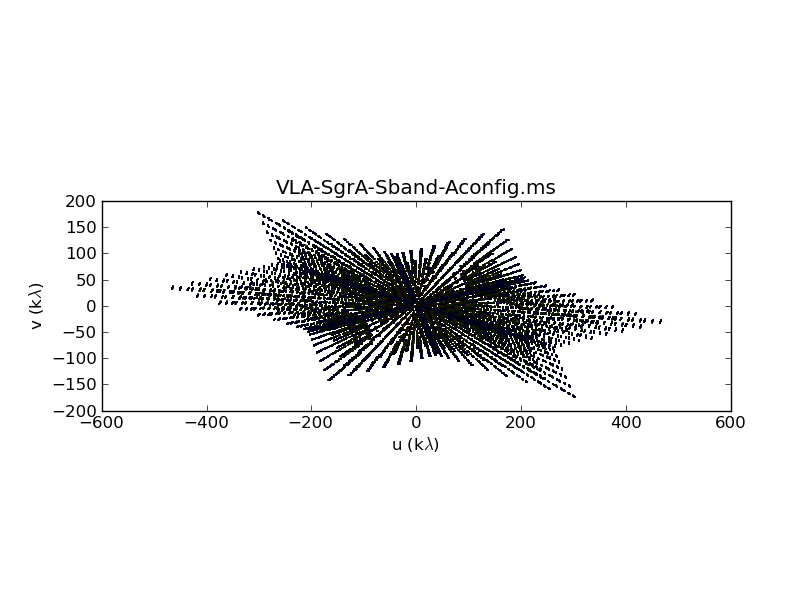 UV-coverage of A-configuration data. |
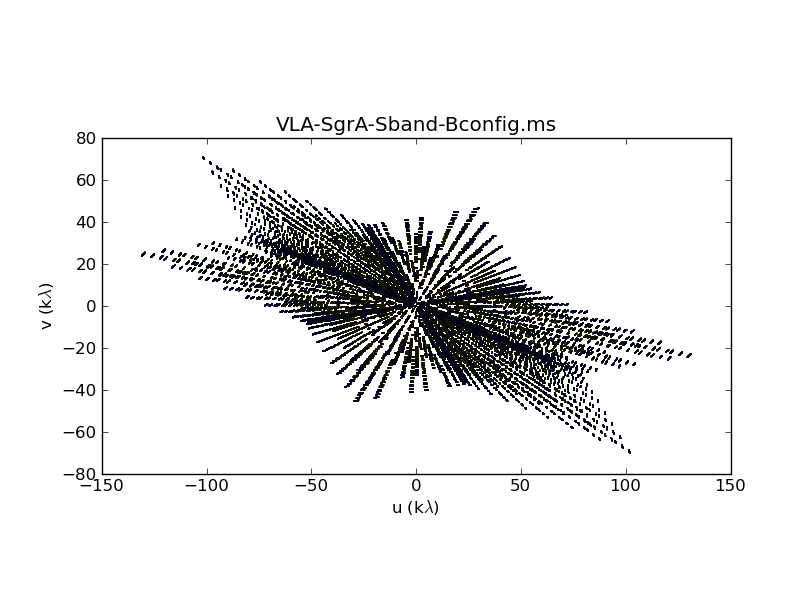 UV-coverage of B-configuration data. |
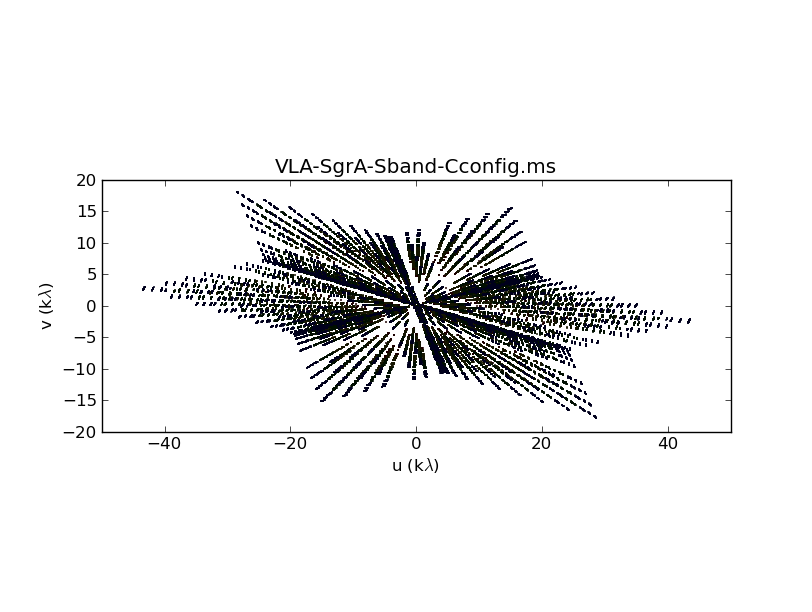 UV-coverage of C-configuration data. |
The next step is to determine the image quality, the synthesized beam, and the rms of each image. To do so, the images do not have to be perfectly deconvolved as we only would like to see how the combination will improve over the individual arrays.
To keep things simple, we will use common cell sizes of 0.1 arcsec, images of 1280 pixels on each side, and we will clean 1000 iterations (see the VLA CASA imaging guide for more sophisticated imaging parameter choices):
# In CASA
# A-config:
clean(vis='VLA-SgrA-Sband-Aconfig.ms', imagename='SgrA-Aonly',field='J1745-2900',
mode='mfs',cell='0.1arcsec',imsize=[1280,1280],niter=1000,weighting='briggs',robust=0)
#
# B-config
clean(vis='VLA-SgrA-Sband-Bconfig.ms', imagename='SgrA-Bonly',field='J1745-2900',
mode='mfs',cell='0.1arcsec',imsize=[1280,1280],niter=1000,weighting='briggs',robust=0)
#
# C-config:
clean(vis='VLA-SgrA-Sband-Cconfig.ms', imagename='SgrA-Conly',field='J1745-2900',
mode='mfs',cell='0.1arcsec',imsize=[1280,1280],niter=1000,weighting='briggs',robust=0)
The clean images, shown in Fig. 2, give a first impression of the data. Note that when combining the images, we will improve on the uv-coverage and will therefore not only combine high resolution with high surface brightness sensitivity on large scales, but also expect a higher image fidelity, i.e. fewer artifacts due to better deconvolution.
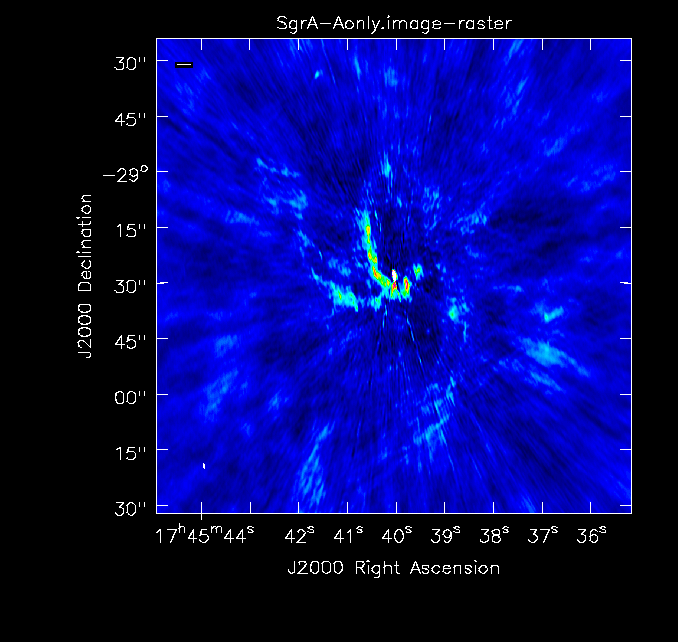 Simple image of A-configuration data. |
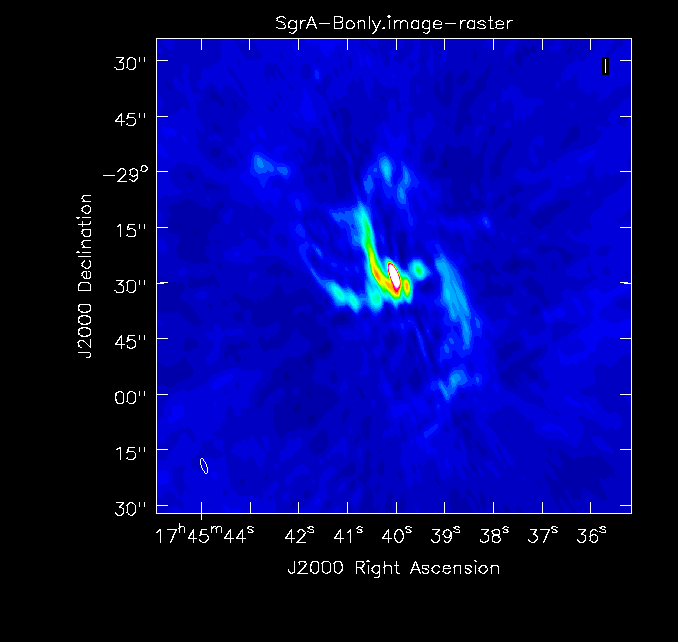 Simple image of B-configuration data. |
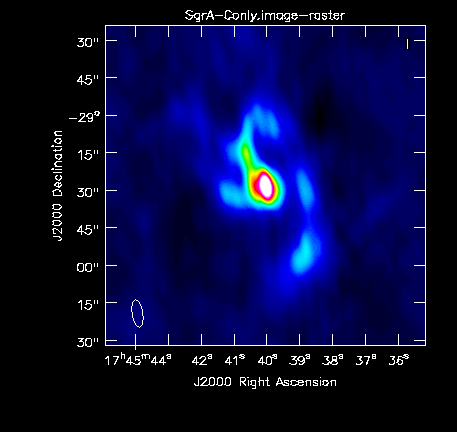 Simple image of C-configuration data. |
The basic parameters of the individual images can be checked through imhead for the spatial resolution, and by determining the rms in the viewer when checking the statistics of empty areas. The central point source, Sgr A*, is variable and we see this reflected in the flux density values from the images taken in the three different configurations, which were separated in observing time by several months:
A-configuration: synthesized beam 1.44" x 0.40"; rms ~0.8mJy; peak flux density of Sgr A* 0.712 Jy B-configuration: synthesized beam 4.33" x 1.34"; rms ~0.7mJy; peak flux density of Sgr A* 0.691 Jy C-configuration: synthesized beam 11.02" x 4.20"; rms ~0.6mJy; peak flux density of Sgr A* 1.35 Jy
Check and Adjust the Visibility Weights
The VLA does not measure system temperatures and does not produce calibrated, absolute weights. VLA weights are currently only based on channel width and integration time. In the future, the VLA may use the switched power measurements to derive absolute calibrated weights. At the moment, however, the VLA weights need to be taken as being relative to each other. The relative sensitivity within an observation is measured by the gain, so weights of single, continuous observation are self-consistent. It is important, however, to adjust the weights between separate observations as they will be on different scales.
Let's have a look at the weights of the different datasets. We will plot the weights as a function of uv-distance, average over all channels in one spectral window, and will colorize by antenna:
# In CASA
# A-config:
plotms(vis='VLA-SgrA-Sband-Aconfig.ms',spw='3',averagedata=T,
avgchannel='64',xaxis='uvwave',yaxis='wt',coloraxis='antenna1')
#
# B-config
plotms(vis='VLA-SgrA-Sband-Bconfig.ms',spw='3',averagedata=T,
avgchannel='64',xaxis='uvwave',yaxis='wt',coloraxis='antenna1')
#
# C-config:
plotms(vis='VLA-SgrA-Sband-Cconfig.ms',spw='3',averagedata=T,
avgchannel='64',xaxis='uvwave',yaxis='wt',coloraxis='antenna1')
Fig. 3 shows that there are some differences. Data from configurations A and B have weights that are reasonably consistent, C-configuration data, however, seems to have consistently lower values.
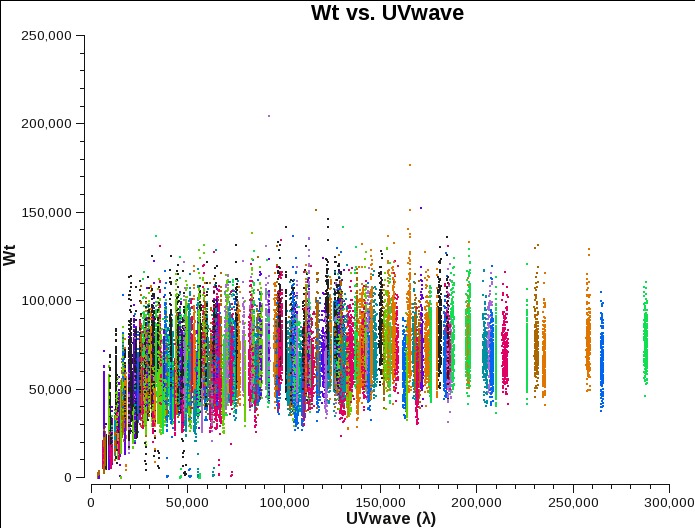 A-config original weights. |
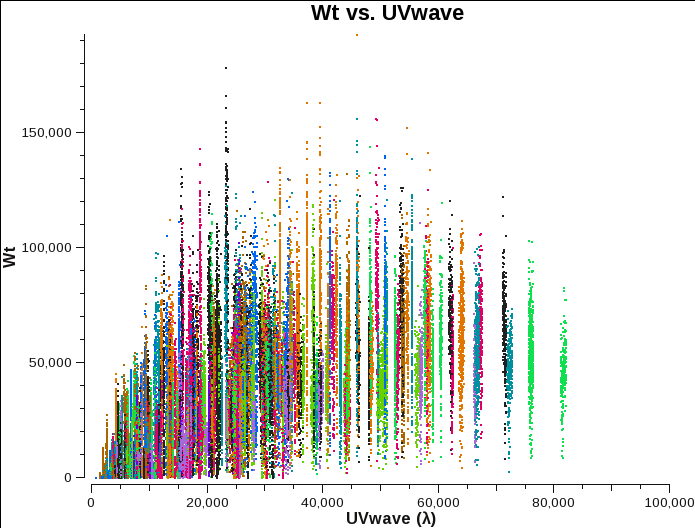 B-config original weights. |
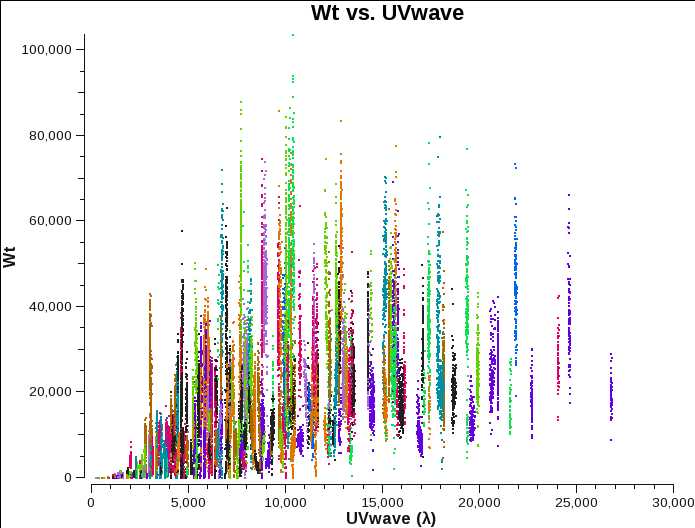 C-config original weights. |
The task statwt in CASA will recalculate the visibility weights based on their rms. statwt is part of the VLA pipeline, which was used to calibrate the original data. This explains the similarity of the A and B configuration weights in Fig. 3. But we nevertheless will run statwt once more on all files in order to ensure proper compatibility of the data (older versions of CASA may have been used for the pipeline, and CASA underwent major changes in its definition of data weights).
statwt needs to be executed on each MS. The default setting calculates the weight based on the rms of each scan and spectral window. This setting works quite well for continuum observations. We would like to note though that for spectral line data the fitspw parameter should be set to exclude the line from the calculations. Otherwise, strong lines will be down-weighted.
As statwt will overwrite the WEIGHT column, we first create copies of our MSs in case we will have to revert to the original data:
# In Linux
cp -r VLA-SgrA-Sband-Aconfig.ms VLA-SgrA-Sband-Aconfig-statwt.ms
cp -r VLA-SgrA-Sband-Bconfig.ms VLA-SgrA-Sband-Bconfig-statwt.ms
cp -r VLA-SgrA-Sband-Cconfig.ms VLA-SgrA-Sband-Cconfig-statwt.ms
Now, we execute statwt on the new datasets:
# In CASA
# A-config:
statwt(vis='VLA-SgrA-Sband-Aconfig-statwt.ms')
#
# B-config
statwt(vis='VLA-SgrA-Sband-Bconfig-statwt.ms')
#
# C-config:
statwt(vis='VLA-SgrA-Sband-Cconfig-statwt.ms')
CASA will come up with a message that the CORRECTED column is not found and that DATA is being used. This is fine as indeed the MS only contains a DATA column as CORRECTED was split out after calibration, which then populated DATA in the new MS.
Let's have a look at the weight values again to see if statwt has adjusted the weights properly:
# In CASA
# A-config:
plotms(vis='VLA-SgrA-Sband-Aconfig-statwt.ms',spw='3',averagedata=T,
avgchannel='64',xaxis='uvwave',yaxis='wt',coloraxis='antenna1')
#
# B-config
plotms(vis='VLA-SgrA-Sband-Bconfig-statwt.ms',spw='3',averagedata=T,
avgchannel='64',xaxis='uvwave',yaxis='wt',coloraxis='antenna1')
#
# C-config:
plotms(vis='VLA-SgrA-Sband-Cconfig-statwt.ms',spw='3',averagedata=T,
avgchannel='64',xaxis='uvwave',yaxis='wt',coloraxis='antenna1')
In Fig. 4 we plot the new, recalculated weights. The absolute scaling has indeed changed, likely due to a different weight definition that was used in earlier versions of CASA when the data were calibrated. The relative weights between A and B configurations still appear to be similar to the original, relative numbers. The C-configuration weights, however, appear to be slightly elevated relative to A and B.
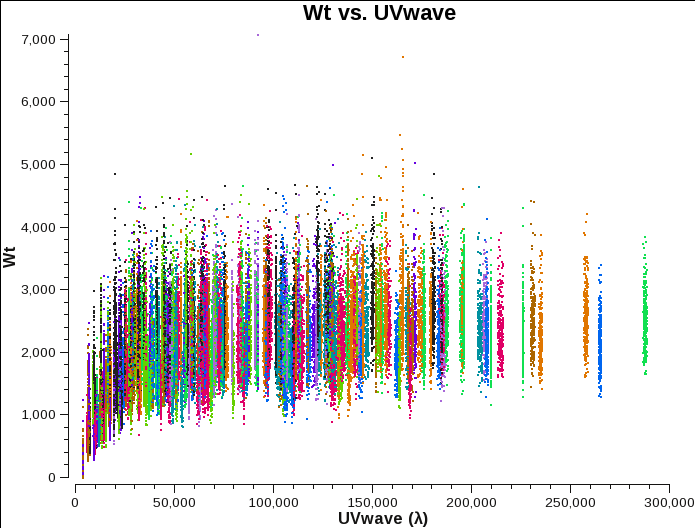 A-config recalculated weights. |
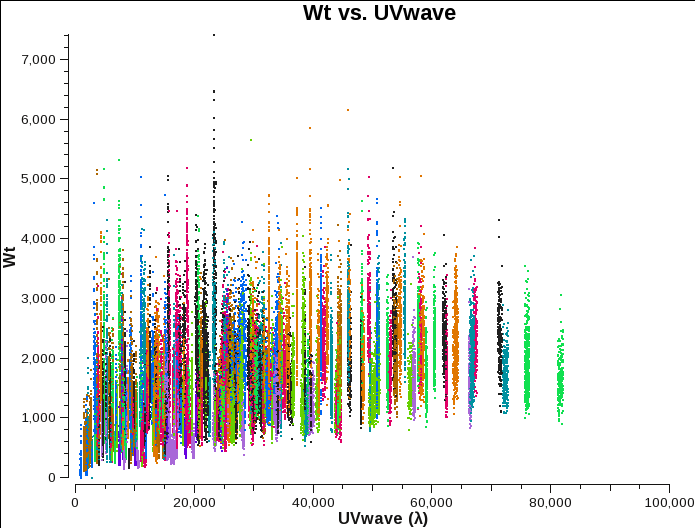 B-config recalculated weights. |
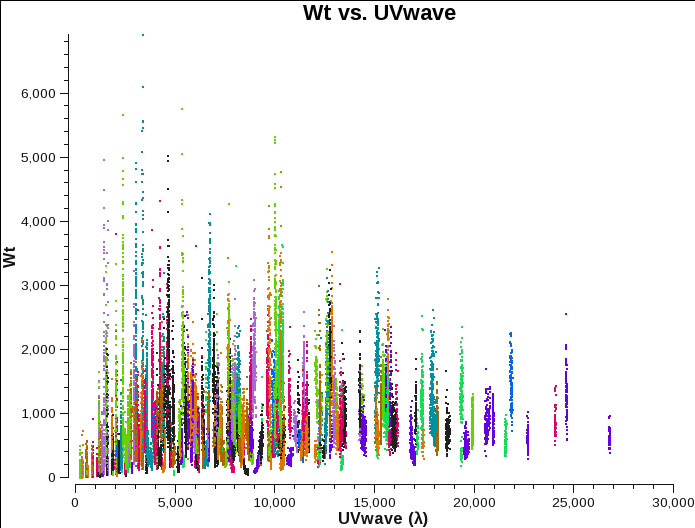 C-config recalculated weights. |
Removal of the variable Sgr A* point source
This step is only necessary for our case which includes a variable source. In most cases, one can skip this step.
As we have seen in the initial images, Sgr A* is a variable source. Unfortunately, this also introduces some problems for data combination as the visibilities will reflect this difference. Cleaning will be difficult in such a situation as flux levels at different uv points (times and baselines) are not consistent in their portion for the central point source. We therefore will remove the unresolved Sgr A* in each dataset and insert a new point source with a consistent, nominal flux value.
To start with, we create a component list for each dataset that includes only a point source at the position of Sgr A* (J2000 RA=17:45:40.03599, DEC=-29:00:28.1699). The component list will be inserted as a model column into the respective MS via ft. uvsub will then subtract the point source model from the CORRECTED data column. Since there's no CORRECTED column to start with, uvsub will initially copy the DATA column to the CORRECTED column. Note that an implication of this procedures is that running uvsub twice will oversubtract. So we recommend to once more create backup copies of the previous datasets before subtracting Sgr A*:
# In Linux
cp -r VLA-SgrA-Sband-Aconfig-statwt.ms VLA-SgrA-Sband-Aconfig-statwt-sub.ms
cp -r VLA-SgrA-Sband-Bconfig-statwt.ms VLA-SgrA-Sband-Bconfig-statwt-sub.ms
cp -r VLA-SgrA-Sband-Cconfig-statwt.ms VLA-SgrA-Sband-Cconfig-statwt-sub.ms
Let's start with the A-configuration data and create a component list of a point sources with a flux of 0.712 Jy at a position of (J2000) RA=17h45m40.03599s DEC=-29d00m28.1699s (more examples are provided in a different CASA guide):
# In CASA
cl.addcomponent(flux=0.712, fluxunit='Jy',shape='point', dir='J2000 17:45:40.03599 -29.00.28.1699')
cl.rename('component-SgrA-A.cl')
cl.close()
The component list is now stored in 'component-SgrA-A.cl' and we will use it to populate the MODEL column via ft:
# In CASA
ft(vis='VLA-SgrA-Sband-Aconfig-statwt-sub.ms', complist='component-SgrA-A.cl')
Finally we will subtract the MODEL from the DATA/CORRECTED DATA with uvsub:
# In CASA
uvsub(vis='VLA-SgrA-Sband-Aconfig-statwt-sub.ms')
Note that to revert back to the original state, one could use clearcal to reset the MODEL column and to set CORRECTED to be identical with DATA (thus undoing the source subtraction).
Let's repeat the steps for B-configuration, now using a flux of 0.691 Jy:
# In CASA
cl.addcomponent(flux=0.691, fluxunit='Jy',shape='point', dir='J2000 17:45:40.03599 -29.00.28.1699')
cl.rename('component-SgrA-B.cl')
cl.close()
#
ft(vis='VLA-SgrA-Sband-Bconfig-statwt-sub.ms', complist='component-SgrA-B.cl')
#
uvsub(vis='VLA-SgrA-Sband-Bconfig-statwt-sub.ms')
And for C-configuration with 1.35 Jy:
# In CASA
cl.addcomponent(flux=1.35, fluxunit='Jy',shape='point', dir='J2000 17:45:40.03599 -29.00.28.1699')
cl.rename('component-SgrA-C.cl')
cl.close()
#
ft(vis='VLA-SgrA-Sband-Cconfig-statwt-sub.ms', complist='component-SgrA-C.cl')
#
uvsub(vis='VLA-SgrA-Sband-Cconfig-statwt-sub.ms')
Finally, we will add in a point source with a canonical flux density of 1 Jy to bring back Sgr A*. reverse=T will add instead of subtract the MODEL to DATA/CORRECTED in uvsub.
# In CASA
cl.addcomponent(flux=1, fluxunit='Jy',shape='point', dir='J2000 17:45:40.03599 -29.00.28.1699')
cl.rename('component-SgrA.cl')
cl.close()
#
# A-config
#
ft(vis='VLA-SgrA-Sband-Aconfig-statwt-sub.ms', complist='component-SgrA.cl')
#
uvsub(vis='VLA-SgrA-Sband-Aconfig-statwt-sub.ms',reverse=T)
#
# B-config
#
ft(vis='VLA-SgrA-Sband-Bconfig-statwt-sub.ms', complist='component-SgrA.cl')
#
uvsub(vis='VLA-SgrA-Sband-Bconfig-statwt-sub.ms',reverse=T)
#
# C-config
#
ft(vis='VLA-SgrA-Sband-Cconfig-statwt-sub.ms', complist='component-SgrA.cl')
#
uvsub(vis='VLA-SgrA-Sband-Cconfig-statwt-sub.ms',reverse=T)
Image Combined Data
We will now create a combined image of all three re-weighted datasets.
First, let's check the new uv-coverage. To do so, we need to concatenate the data with concat:
# In CASA
concat(vis=['VLA-SgrA-Sband-Aconfig-statwt-sub.ms','VLA-SgrA-Sband-Bconfig-statwt-sub.ms','VLA-SgrA-Sband-Cconfig-statwt-sub.ms'],concatvis='VLA-SgrA-Sband-combined.ms')
#
plotuv(vis='VLA-SgrA-Sband-combined.ms')
Fig. 5 shows the combined uv-coverage, which extends to A-configuration baselines but with a much higher density at the intermediate and shorter baselines contributed from B and C configurations.
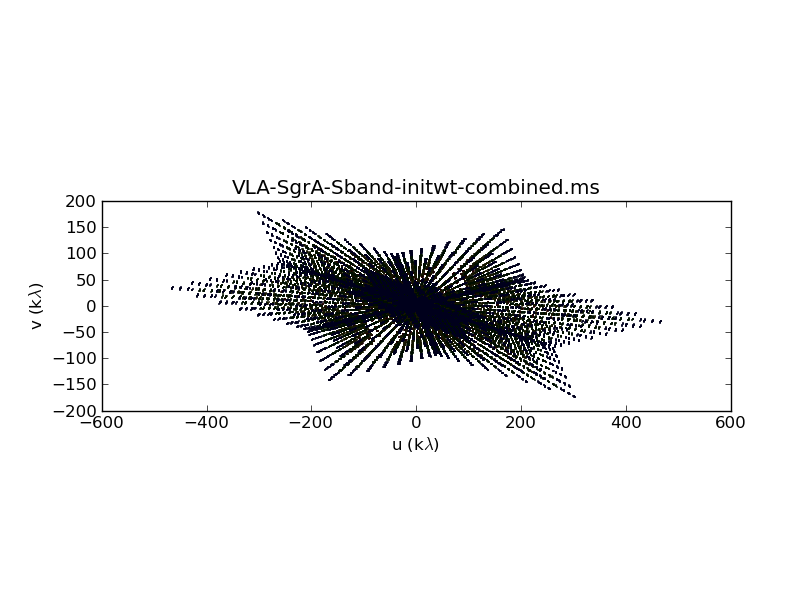 Combined uv-coverage. |
Although concat merges all three MSs into a single one, it is actually not a required step before imaging. clean will take care of the combination when all datasets are specified as a list. By default, clean will image the data in the CORRECTED column, i.e. it will use the portion of the MS which exhibits the replaced Sgr A* point source (if CORRECTED is not present, it will image the visibilities stored in the DATA column). Clean will also perform the spectral regridding of all datasets on the fly, when mode="velocity" or mode="frequency". There's no need to cvel the MSs beforehand.
We will now create a combined image in clean. The threshold parameter was derived by a previous run of clean in which we determined the rough rms noise. For our threshold, we will use the rms noise multiplied by a factor of ~2.5:
# In CASA
clean(vis=['VLA-SgrA-Sband-Aconfig-statwt-sub.ms','VLA-SgrA-Sband-Bconfig-statwt-sub.ms','VLA-SgrA-Sband-Cconfig-statwt-sub.ms'],
imagename='SgrA-all',field='J1745-2900',mode='mfs',cell='0.1arcsec',imsize=[1280,1280],niter=5000,
threshold='5mJy',weighting='briggs',robust=0)
The resulting image has a beam size of 1.58" x 0.50" (Fig. 6), very similar to the resolution of A-configuration only. This is what we want to achieve. The rms is with ~2mJy better than A-only and there are clearly many more extended spatial scales in the image. This is a pretty good combination product.
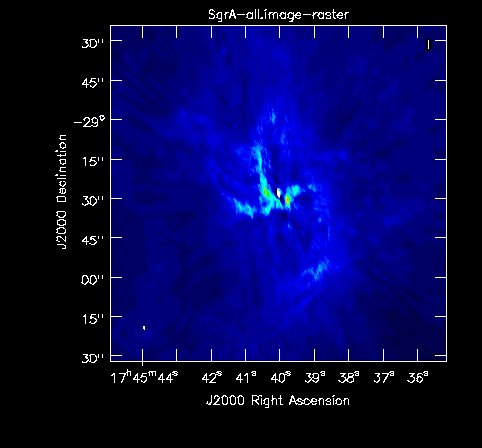 Combined image. |
The image can still be improved. For simplicity, we did not use any interactive cleaning in the above, but we highly recommend it for producing the final images. Improvements can also be obtained, e.g., by adjusting the image weights via the Briggs robust parameter, adding a taper, or weighting the different datasets against each other (using visweightscale in concat). Wide-band imaging and multi-scale imaging will also lead to better results. We refer to the VLA CASA Imaging Guide for more details and examples.
Tips for Selfcal
If the source has a bright nucleus [or bright unresolved emission generally], start with the A array data, selfcal, then add B array, selfcal again, and so on. If the source is mostly diffuse, then there is not much signal in the A array data, so start with the D array, selfcal, then add C array, selfcal, and so on. Each selfcal step should be phase only first with maybe two or more iterations. At the end of each selfcal step, a phase+amplitude selfcal can be attempted, before merging in the next array configuration data. After each merge the selfcal steps can be repeated.
Last checked on CASA Version 4.6.0